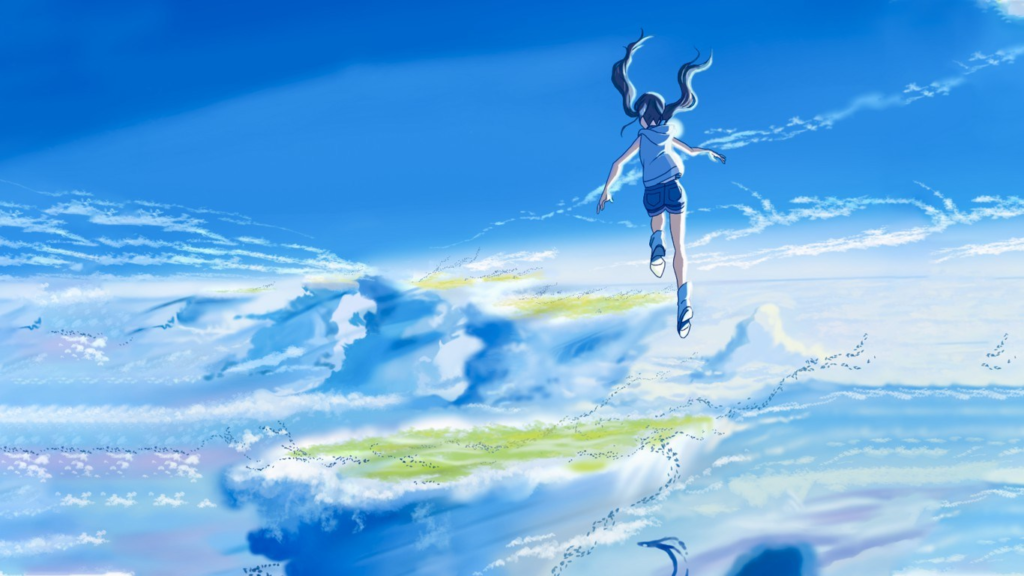
With Makoto Shinkai’s latest cinematic release, I come to the end of my 6-day anime movie marathon, courtesy of Scotland Loves Anime at the Belmont Filmhouse in Aberdeen. This was a re-run of films first shown back in October at the 2019 festival in Glasgow and Edinburgh. Technically the showing of Weathering With You that I attended wasn’t part of the season, as I couldn’t manage last Friday’s original showing on the first day. But I’m going to count it anyway. In a contrast to the relatively sparsely attended Belmont showings, the larger Cineworld where this was shown was packed with barely any seats spare. I’ve never seen an anime movie as well-attended here before. Shinkai’s previous Your Name surely has a lot to answer for in terms of fans’ heightened anticipation for his next work.

Let’s get to the inevitable comparisons. This is not a retread of Your Name. Sure, as with all of Shinkai’s works there are his prominent themes — adolescent love, separation anxiety, plot-device mysticism, gorgeously-painted landscapes and skies that are probably best described as “scenery-porn”. Much like his previous films, this is a watercolour wonder of crisp hues, dancing light sources and dramatic composition. Compared to Your Name though, the story strikes a different tone altogether. In order to explore this, I’m afraid SPOILERS WILL BE INEVITABLE, so if you’ve not watched it yet, you’re probably best to skip to my concluding paragraph.

Hodaka Morishima is a 16-year old high-schooler who runs away from his island home for reasons unspecified. He first appears covered in sticking-plasters so I wondered if perhaps he was fleeing from parental abuse at home? On his departing boat ride, his life is saved during a storm by the slightly unsavoury-looking Keisuke Suga who I wondered initially if he was a gangster. Hodaka discovers that trying to survive in the big city (Tokyo) is much harder than he anticipated and his attempts to find a job, affordable food or even shelter seem doomed to failure. Finding himself sleeping rough, he discovers an abandoned firearm in a recycling bin and rescues Hina Amano, a teenage girl, from two very pushy men attempting to forcibly employ her as a seedy club’s hostess.

In desperation, Hodoka turns to Keisuke who turns out in fact to be an editor for an independent magazine that covers supernatural urban legends. He provides Hodoka food and shelter in return for dogsbody and journalistic duties. One of his tasks is to research and identify “the sunshine girl”, an online rumour about a girl with the power to bring brief periods of sun to the endless rain that has ruined Tokyo’s summer. Turns out of course that Hina is the sunshine girl, and together she and Hodaka formulate a business plan — she can use her powers to bring sunshine to order for those that need it (and are willing to pay) and they use the power of the internet to publicise themselves.

A big part of the film’s strengths are in its characters. Hodoka himself is always close to desperation and this drives him in a way different to the usual self-insert anime teenage boy character. For although this was marketed as a fantasy/romance film, he is mostly driven by the need to survive, with his attraction to Hina (at least initially) a secondary concern. His relationship with her is almost an extension to his survival instincts, as she too is in trouble — as an orphaned daughter looking after a little brother, she is working to keep her small family unit together. Hodoka identifies strongly with this and does everything he can to protect Hina, and her brother. He realises his romantic feelings only later, after he has already selflessly helped her.

In Your Name, the central couple were separated by time and space and barely interacted with one another directly. Here, they are together through much of the film and that makes their inevitable estrangement all the more painful. It wouldn’t be a Makoto Shinkai production without tragic separation and painful longing. Unlike with sa y, 5cm Per Second, this theme does not overwhelm the movie with melancholy to the point of frustration. This is a more plot-driven work than many of his earlier films, though what plot there is is very simple. You shouldn’t expect mind-blowing twists or complex narrative inversions.

Special mention is warranted for the supporting characters who do so much to elevate this film above Shinkai’s baseline. Of particular note is Hina’s little brother Nagi Amano. He’s an elementary school lothario who lectures Hodaka on how to treat women. His easy attitude, wily wits and sharp humour drew frequent laughs from the audience. A particularly inspired later scene involves a three-way conversation between Nagi and two adoring girls that leads to police officer deception via cross-dressing. I didn’t expect that.

Keisuke, as I mentioned above, initially seems like a deeply untrustworthy character, despite the fact he saves Hodaka from falling overboard in his first scene. He is a more complicated, conflicted character who hides his personal struggles beneath his slovenly, rough exterior. Both supportive and antagonistic to Hodoka he fulfils a kind of father-figure role, and other characters comment that the two have similar personalities. His niece Natsumi (who Hodoka hilariously misidentifies as Natsumi’s mistress) fulfils an almost maternal role for Hodaka- albeit a motorcycle-riding, teasing, unpredictable one. Neither of these adults are particularly great role models on the surface, but they play important parts in progressing the story and supporting the younger characters.

Police officer Takai, he of the ridiculous bouffant haircut, reminds me of inspector Zenigata from Lupin III or Javert from Les Miserables in that he is an over-eager cop with a somewhat skewed priority in regards to justice. The whole audience laughed during a chase sequence when his hair boinged back and forth comically. His role is to bring conflict. Hodoka is a runaway but he’s treated like a criminal (due to the gun) and Hina is a minor acting like a mother to her even younger brother, under the radar of Social Services. These kids have more real problems than the majority of anime teenagers.

Your Name was a romance/comedy film that took a turn towards the disaster movie at the end. Weathering with you also integrates that mish-mash into its DNA, but in a more overt way. Tokyo slowly drowns throughout the film due to the constant 72-day deluge that apparently only Hina can stop by sacrificing herself. That makes the disaster at once both more personal and more widespread than in Your Name. It brings up an ethical conundrum absent from the previous film — Hina has the power to stop this if she wants to, but she has to give up her life. During the climactic sequence where Hodoka strives to save her, you know there will be some price to pay. And that price… is what people have referred to when they describe this as an allegory about global warming.

I don’t think this is a particularly good allegory, and I don’t think the intention was for it to be one either. For one, as an allegory the messaging is hopelessly muddled. MASSIVE ENDING SPOILER — Hodaka chooses to sacrifice his environment and the welfare of an entire city so that he can save the life of the girl he loves. This is completely believable — why should someone arbitrarily sacrifice themselves to please unspecified supernatural forces for the so-called greater good? It does make the ending incredibly ballsy. No mainstream Hollywood film would dare to end like this, with such a huge price paid by the world for the sake of a single, selfish (but natural) desire. It tells us nothing about climate change or how we should tackle it, or feel about it. I can only hope that after the end of the film that Hodaka and Hina move to the Sahara Desert and take the Massive Permanent Swirling Cloud Vortex Of Eternal Rain somewhere it is really needed. Perhaps Hina is really more of a rain girl than a sunshine girl, as the rain will never leave until she dies…

As yet, I’m unsure if I prefer this to Your Name or not. I certainly prefer it to all of Shinkai’s other films. (The only other I have not seen is Garden of Words). It has plenty of funny moments and it evokes genuine emotions of hope and fear. The pacing is good and it is rarely boring. It is not a religious experience — I was never astounded by it, but I was always entertained. I think I probably preferred yesterday’s more overtly hand-drawn, less-sterile Ride Your Wave, but Weathering With You is most definitely a more commercial film. For once, it had real-life product placement in it. No cheeky anime “MgRonalds” restaurants — there are real Big Macs in this. If that doesn’t tell you something about this production, then nothing will. Weathering With You confirms that Your Name was not a fluke, and despite it including his continuing obsessions, I’m glad to report that Makoto Shinkai produced an excellent movie that widened his scope and bodes well for his future output.
Weathering With You
Written and directed by: Makoto Shinkai
Produced by: CoMix Wave Films
Music by: Radwimps
Japanese Cinematic Release: July 19th 2019
Runtime: 112 mins
You’re reading AniTAY, a non-professional blog whose writers love everything anime related. To join in on the fun, check out our website, visit our official subreddit, follow us on Twitter, or give us a like on our Facebook page.

Get involved!
Comments